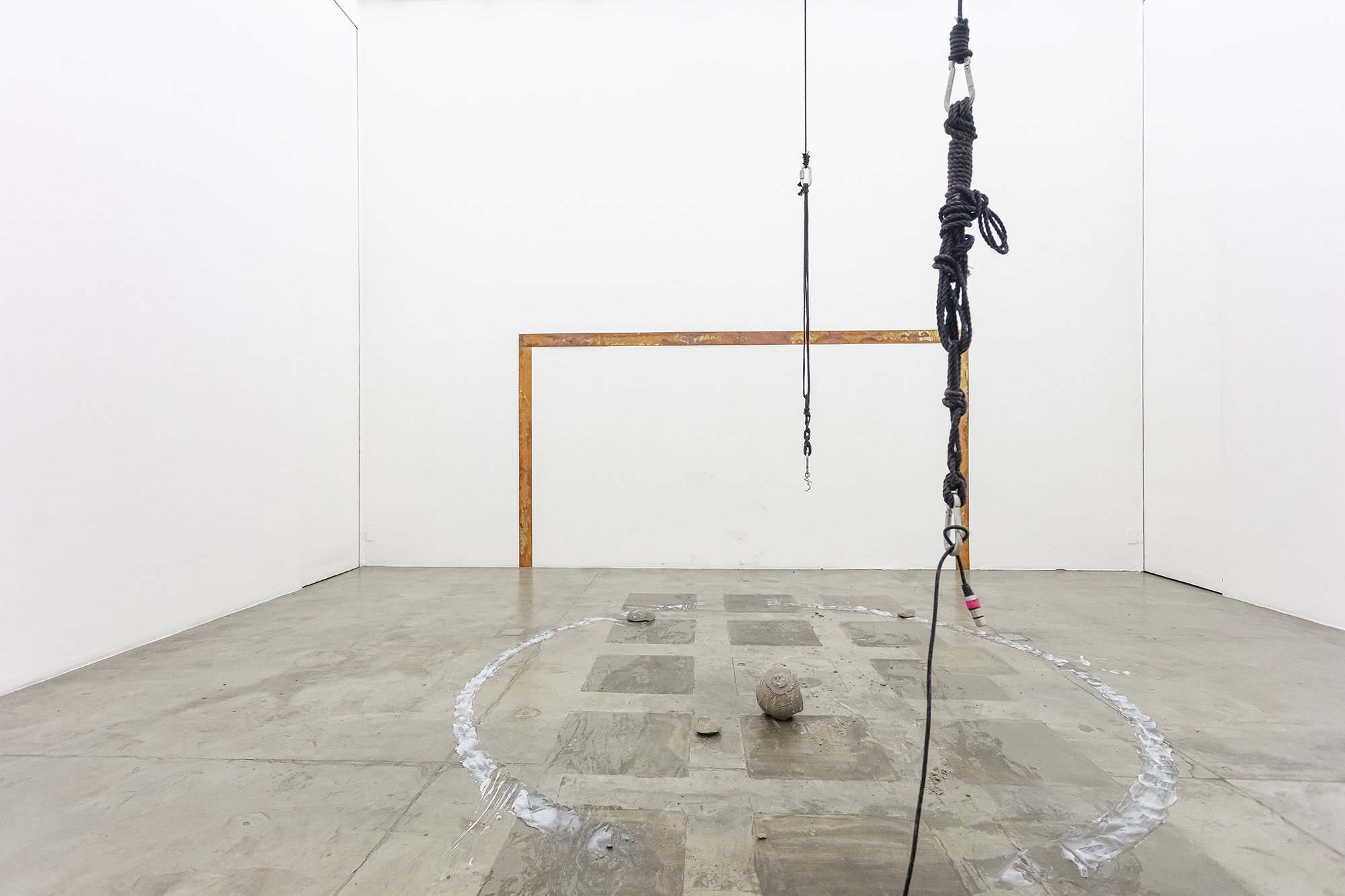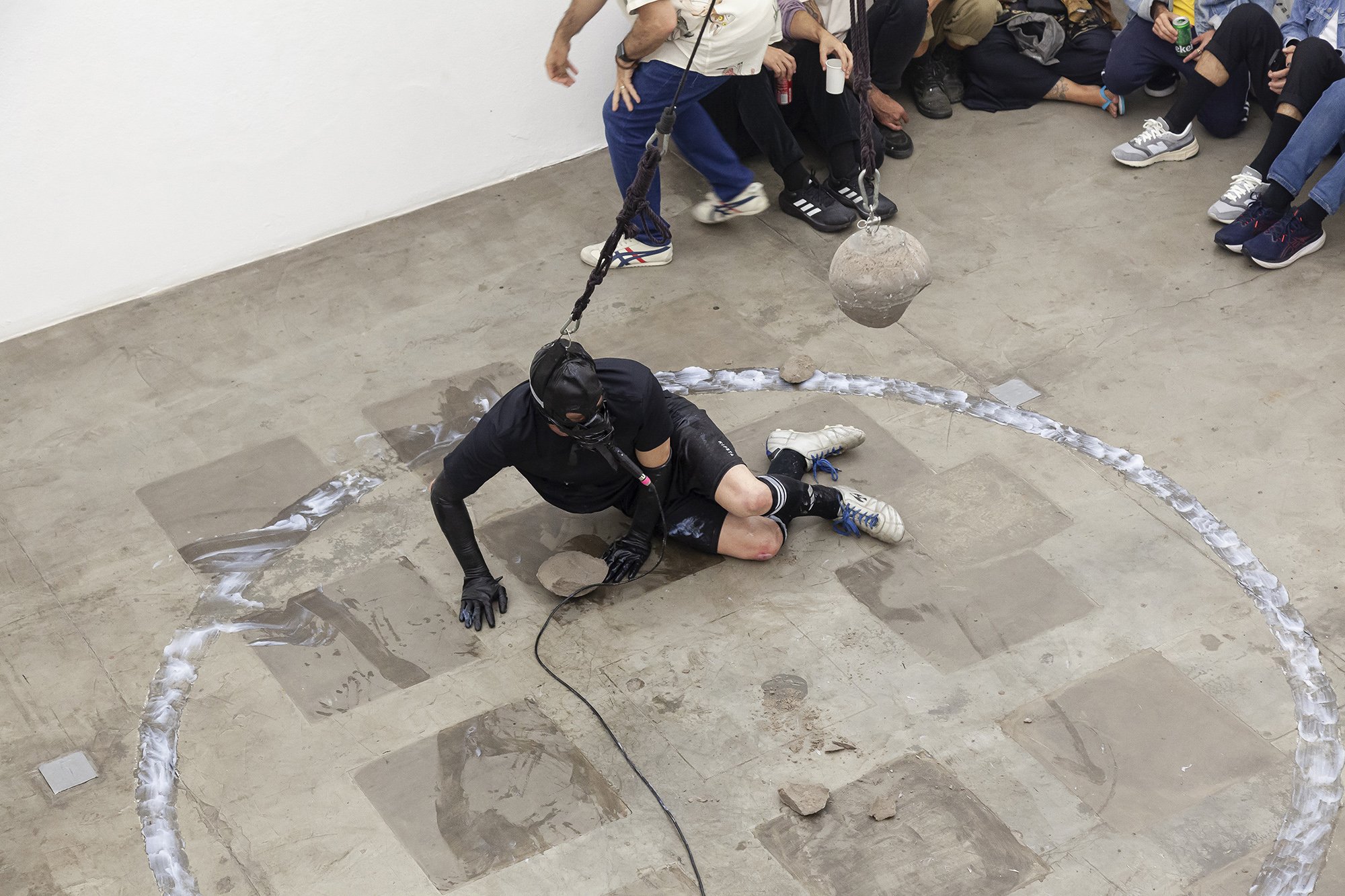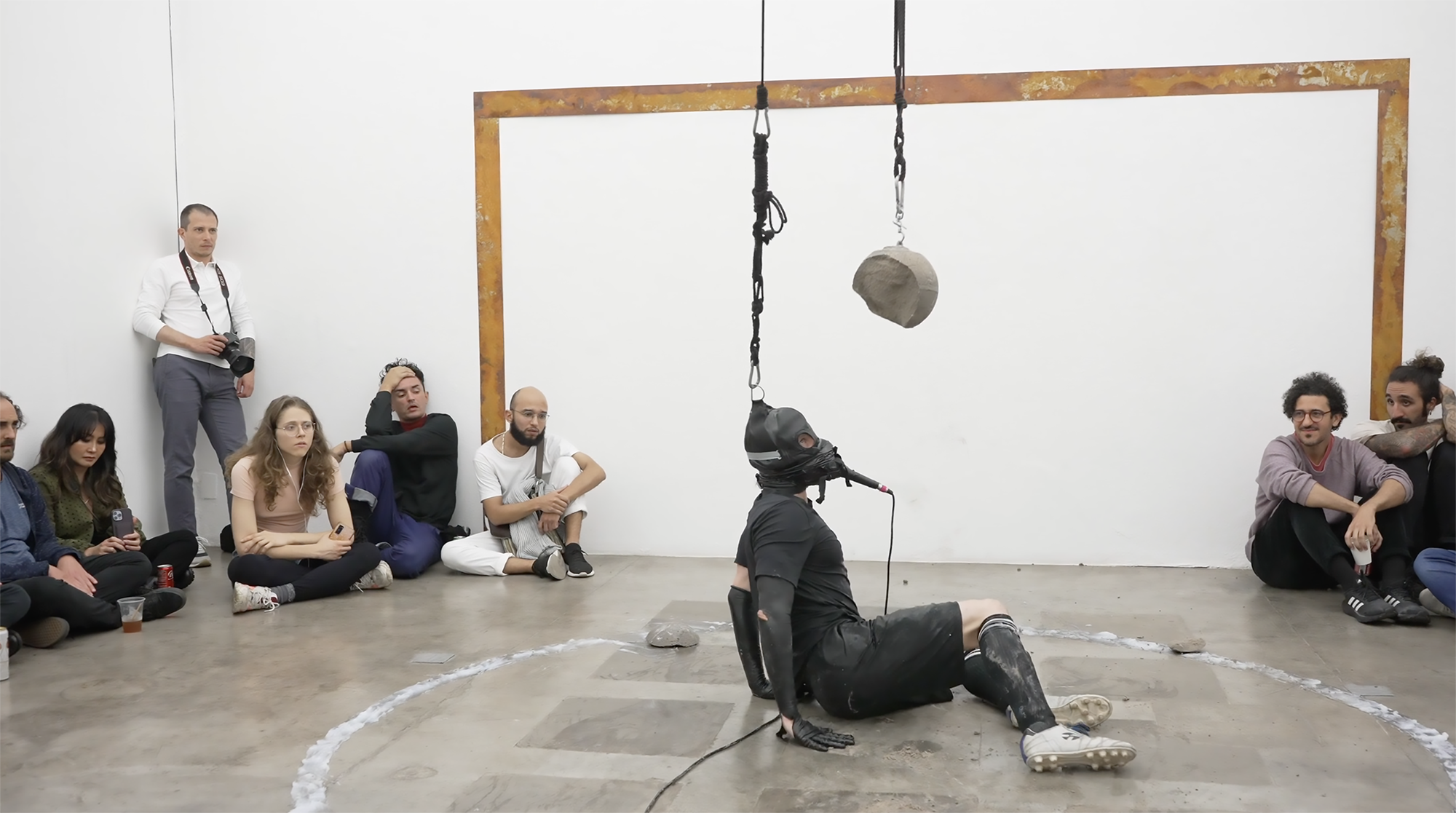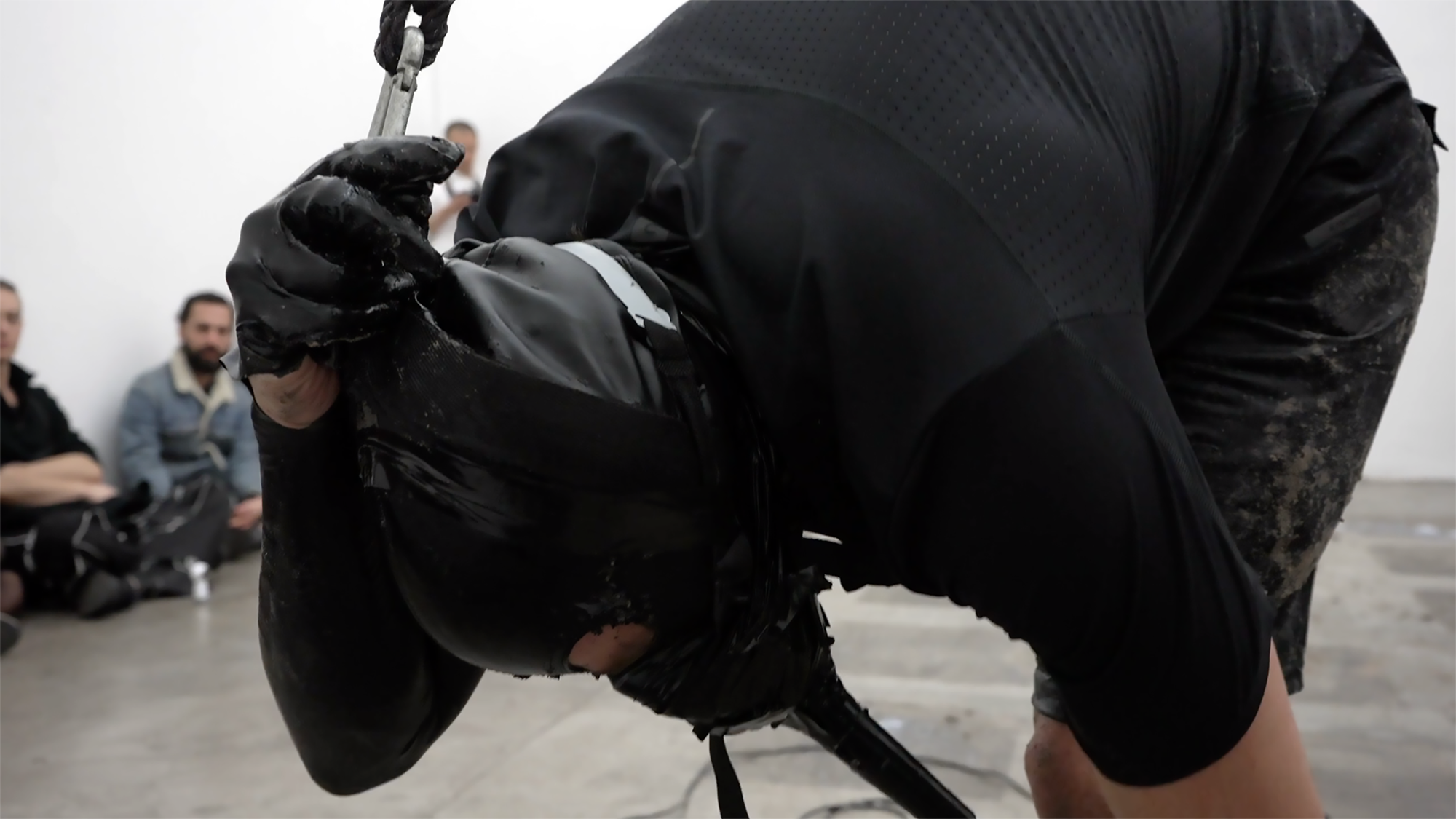The Performing Body Between Disidentification and Necropolitics




A grotesque football player dressed in black, the performer (Guilherme Peters) stands at the center of a circle on the floor, drawn out of Vaseline. The helm of his full-head, black leather mask connects with a rope and pulley system to a solid cement ball in the middle of the circle. In turn, a microphone is taped on the outside of the mask against the performer's mouth. The stage is further set by strips of oxidized iron sheets, the outline of a football goal net, mounted on the wall. The performance happens in a space defined by multiple signifiers that relate the performer's body to various apparatuses and practices such as sports, sexual practices, and politics. Another essential aspect delineating the semantic contours of the work is the context of contemporary Brazil, Guilherme's country of origin.
The choreography of the performance consists of Guilherme’s repeated attempts at scoring a goal with the cement ball; his clumsy attempts are an endless series of failures. With every new movement, the Vaseline spreads further out on the ground; a slippery territory unfolds, causing Guilherme to fall and misperform his actions continuously. A choreography of slipping emerges, which brings to the fore the image of a fragile and vulnerable body constantly being pushed out of balance, faced with the impossibility of performing as intended. The movement sets in motion the ball that is attached to the body with a pulley system. Every time Guilherme tries to get to the ball, it swings away and smashes onto the ground. As the performance progresses, the ball breaks apart, leaving behind more and more fragments of broken concrete. This absurd choreography, composed of failures and fallings, embodies the kinetic energies of submission that can be understood as an immanent feature of the necropolitics of our times.
Nowhere is this fatal and perverse relationship between violence, politics, and oppressed corporeality better manifested than in the geo-political context of Brazil, with its complex and contradictory layers of coloniality and modernity. I aim to illuminate the entanglements of art and socio-political issues by interpreting the performance as a somatic expression of affective politics. Furthermore, I would like to demonstrate how Guilherme´s work inspires reflection upon overlapping points between anthropology and performance. In so doing, I will examine the choreographic composition of the piece, concentrating on the bio-political aspects of the movements and their specific figurations. However, before elaborating on the theoretical framework, let me return to the multiplicity of figures Guilherme embodies.
Formally, the movements are composed of an accumulation of running, falling, crawling, and slipping away. Sonically, the actions of the body are enhanced by the microphone, which not only creates a specific soundscape of intensive breathing but also proliferates the sense of carnal presence and the delicate sensuality of a suffocating subject. The exaggerated and failed attempts at hitting the concrete ball resulted in bruises and wounds on Guilherme´s flesh. Hence, oscillating between autoerotic and sadomasochistic desire, the performance materializes a liminal space. The bruises and cuts make the performance appear as a living organism, with the body switching dynamically and rhythmically from being the subject to being a body subjected to violence.
While Guilherme´s figure dressed in a black uniform produces the image of a grotesque and estranged football player, it also can be seen as embodying a strange, dark, suicidal ritual. This ambiguous figuration is additionally complicated by the performer hiding behind the mask; the hidden face suggestive of an identity breakdown, confronting the audience with an anonymous body performing a series of paradoxical gestures. This situation in which the identification process is subverted can further be envisaged as an attempt to deconstruct the regime of representation. Guilherme´s focus on the imaginaries and structural elements of football (ball, goal, circle) establishes a critical relationship between art and mass entertainment (football,) which in Brazil is the most popular sport and, as such, plays an integral part in the shaping of the national pride and identity.
A country with a complicated colonial heritage, during the last fifty years, Brazil has become the battleground of significant clashes between conservative (embodied best in the dictatorship which lasted from 1964 to 1985 and in the recent rule of Jair Bolsonaro) and leftist politics (João Goular and Lula da Silva, the current president.) The disastrous environmental and social policies practiced during the reign of Bolsonaro have revealed the toxic alliance between right-wing, nationalist politics and militarisation. (See: Vidigal, 2022.)
Spatially, the performance happens with the audience encircling the scene and the artist's body. It implies that a distance is created and that the performance draws a clear division between the work and the audience. Without aiming to displace them from a voyeuristic position, Guilherme creates an aesthetic condition in which the gaze of the other (the audience) functions as a surveillance mechanism. Such a topology mirrors the asymmetric power relations of the dominant scopic regimes of late capitalism and embodies constitutive friction between the “I” and the “other.” Concurrently, the fact that the audience is cut off from the action and can not interact turns the performance into a closed system with its own rules.
Drawing on the dance scholar André Lepecki who analyses the concept of choreopolice and applies it to the context of contemporary Brazil, it can be argued that Bolsonaro (together with Trump) “were elected to kill the liberal state.” (Lepecki 2022: 71) For Lepecki, Bolsonaro´s rule made apparent the connection between the social and economic, the police and state forces, the result of which is the demise of the political. Seen through this optics, we could assert that Guilherme´s performance “The submissive body trying to play with the libidinal economy” embodies and portrays precisely the process of a crumbling democracy and the affirmation of militant nationalism.
Organizing the performance around the signifiers of football, the artist refracts the end of the political through the ritual of sport. In preparation for the 2014 World Cup and 2016 Olympic Games, the largest favela in Rio de Janeiro was raided by heavily armed police troops whose task was to conciliate the gangs and the lower class. The operation was followed by a grave overuse of violence.
The intervention in the favela can also be seen as tactics aiming at evicting the population, which, from the point of view of housing policies, resulted in extreme real estate speculation. Following Rod Sweet, who analyzed the 173-page report of the Committee on the World Cup and Olympics, it can be argued that such removal and forced evictions coupled with police pacification “represent a form of social cleansing” (Sweet, 2014). The result is the reproduction and affirmation of social division, which enhances the struggle between the poor and the rich. In other words, the policing and eviction performance supports the conservation of the status quo and the proliferation of heteronormative, white, and middle-class subjects.
As Achille Mbembe suggests, echoing the ideas of Michel Foucault and Hannah Arendt, the murderous mechanism of the state, as it gets shaped through the relationship between politics and death, “appears to function by dividing people into those who must live and those who must die.” (Mbembe, 2019, 71) In that way, terror and killing underpin not only the colonial project but are constitutive of the modern idea of the state, which ended up aligning working classes and homeless/stateless people with the indigenous groups of the colonial world. For Mbembe, this condition of dehumanization and exclusion that characterizes our “democratic” societies can be designated with the concepts of necropolitics. As a concatenation of multiple powers (disciplinary and biopolitical), necropolitics signifies the interwovenness of the military apparatus and technologies of subjugation.
Returning our analytical gaze back to the performance and the figure of the body wearing a black uniform with a mask and a microphone attached to the head, we could think of something which, following Mbembe, is “a form of death-in-life (...) the perfect figure of the shadow” (Mbembe, ibid., 75.) Hence, it could be asked if it is plausible to assert that Guilherme personifies and embodies the state of terror/violence, which is a defining feature of colonial regimes and capitalism? Furthermore, the fact that the body in the performance is confined and enslaved by the pulley system makes it appear as a figuration of a modern-day Sisyphus condemned to repeat an impossible task.
“To live under late-modern occupation,” writes Mbembe, “is to experience a permanent condition of ´being in pain´: fortified structures, military posts, and roadblocks everywhere; buildings that bring back painful memories of humiliation, interrogations, and beatings (...).” (Mbembe, ibid, 92.) Interpreting the performance with this in mind, I am arguing that it reveals the necropolitical subjugation of life to the spectacle and power of death and terror. In doing so, Guilherme´s work directs our attention to the blurred lines between resistance, suicide, and freedom, whose affective entanglements are experienced in the choreography of the slipping flesh and the dissipating matter it sets in motion.
Radicalizing the idea of necropolitics as the foundation principle of the modern and postmodern state, Vladimir Safatle demonstrates how Brazil has become the stage for the implementation of a suicidal state, which is a new step in the managerial models immanent to neoliberal capitalism. He writes: “A state like ours is not just a manager of death. It is rather the ongoing agent of its own catastrophe, the maker of its own explosion. To be more precise, this new state mixes the death management of entire sectors of its own population with an ongoing and risky flirting with its own self-destruction.” (Safatle, 2020) Written when Bolsonaro´s power seemed indisputable, Safatle identifies something he refers to as the undeclared civil war, a condition of total militarization and a return to the pre-social war of all against all.
The strategy of subjugation deployed throughout the performance turns the event into a playground for confronting the politics of nationalism, which, in Brazil's context, is defined by the activities and libidinal economies of football. Guilherme notes that there is even a coincidence between the four-year cycle of political elections and the World Cup. Reacting to these circumstances and the fact that, as of 2016, several extreme right-wing nationalist movements appropriated the uniform of the Brazilian soccer team as a symbol of their ideology, we could conclude that the performance operates on the level of disidentification.
Reflecting on disidentificatory performances as a queer tactic for undoing the fiction of identity and thereby questioning the cultural logics of heteronormativity and white supremacy, José Esteban Muñoz proposes to see it in the light of a minoritarian subject formation capable of activating new social relations. For him, it entails the activation of conflicting sites of identification, and “these new social relations would be the blueprint for minoritarian counter-public spheres.” (Muñoz, 1999, 5) In this way, Guilherme´s performance reacts to the subject formation of the dominant Brazilian culture shaped by football and, in doing so, counters the dominant identification matrix. Another critical element of the performance is the allusion to BDSM activities, which imply the use of physical restrain, control, and pain to achieve sexual pleasure. Hence, the figure of the uniformed body performs a choreography of disidentification, staging an image of resistance against the mechanism of national representation and identity.
Understanding identification as a psychological and discursive-performative process through which personality is constituted, a disidentifying subject resists easy assimilation into the social order and its prevailing norms. In other words, Guilherme moves towards an antagonistic, emerging identity-in-difference, which Muñoz defines as follows: “These identities-in-difference emerge from a failed interpellation within the dominant public sphere. Their emergence is predicated on their ability to disidentify with the mass public and instead, through this disidentification, contribute to the function of a counterpublic sphere.“ (Muñoz, ibid., 7) In the case of the performance, the counterpublic sphere comes into being as a refusal to conform and affirm the spectacular image of football. Instead, the iterations of the gestures of falling and slipping result in unruly kinetics, exposing the unbecoming national and nationalist subject that has been shaped by the violence of the police apparatus and the identification with the ideology of football.
If we look for a specific figure expressing the concept of identity, it could be found in the myth of Narcissus. Drawing on the research by Eduardo Viveiros de Castro, it could be said that Narcissus is the foundational figure for anthropology and the Western metaphysics that “is truly the fons et origo of every colonialism.” (de Castro, 2014, 44) Intending to decolonize thought, thus introducing the concept of minor and indigenous anthropology, de Castro points to the importance of an economy of corporeality. In other words, “an indigenous anthropology formulated in terms of organic fluxes, material codings, sensible multiplicities, and becomings-animal instead of spectral terms of our own anthropology (...)” (de Castro, ibid., 54). With this in mind, it could be asked if the work, understood as a performance of disidentification, mirrors precisely such a minor anthropology. Can we claim that the slipping body and its ephemeral materiality is a performative portrait of anti-narcissus?
The choreographic affect of becoming-other in Guilherme´s performance invokes the atmosphere of a dark ritual in which he invokes the image of a shaman. Are we thus witnessing some sort of exorcism in which the self-inflicted violence echoes the suicidal machine of the state that needs to be demolished? Describing the figure of the shaman, de Castro illuminates that it is both the carrier of the priest's role and the medium of sacrifice. Another vital element of de Castro´s theory is that shamanism allows us to rethink the concept of death and link it to other forms of life. “Dead humans,” writes de Castro, “begin to be seen more as humans than as dead, and this opens the symmetric possibility of a more realized `objectification` of nonhumans.” (de Castro, ibid., 156) In this view, the dead continue to be and to have the form of a beast, and every beast continues to be somewhat human.
Guilherme brings to the fore with his ritual an ambivalent figuration oscillating between deidentification and an affirmation of undisciplined, unruly desire. On the other hand, the specific apparatus in which the artist is embedded makes him appear no longer human. In that way, the border between the human and the nonhuman is made porous, giving way to a liminal experience. Hence, by situating the performance in an antagonistic constellation in which dominant state representations and national subject formations are contested, Guliherme galvanizes the clash between the vital forces and the necropolitical, suicidal technologies of neoliberal politics.
Played out as a strange, auto-destructive ritual, the performance confronts the audience with the toxic structures of nationalism and violence, which are carefully rehearsed on football fields and whose agents are coming from criminal and paramilitary milieus. The slippery choreography resulting in an iteration of failures to hit the ball engages in materializing trajectories of dissent that are subversive to the necropolitical condition of global capitalism. The affective construction of movements sets the body in the force field of (auto)erotic pleasure and the power of the death drive. What unfolds out of the tension is a circulation of unbecoming. It sets a flow of desire in motion, challenging the fatal nationalist imaginary of ordered, uniformed, and clean bodies.
Andrej Mircev
November, 2023
—————————————————————
References:
André Lepecki, The Demise of the Political-or, the kinetics of the killing machine, in: Maska, a Journal of Performing Arts, Ljubljana, 2022, Vol. 37., Nr. 207-208.
Achille Mbembe, Necropolitics, Duke University Press, 2019.
José Esteban Muñoz, Disidentifications. Queers of Color and the Performance of Politics, Minnesota University Press, 1999.
Eduardo Viveiros de Castro, Cannibal Metaphysics, Minnesota University Press, 2014.
Robert Vidigal, Authoritarianism and Right-Wing Voting in Brazil, Latin American Research Review, Volume 57, Issue 3, 2022
https://www.cambridge.org/core/journals/latin-american-research-review/article/authoritarianism-and-rightwing-voting-in-brazil/26A9D9D50098C512A6D96729697A99A1
Rod Sweet, Thousands of Rio´s poor evicted for World Cup
https://www.globalconstructionreview.com/thousands-rios-poor-evicted-world4-cup-dossier3783/
——————————————————————
Images courtesy of Felipe Bernt (1), Iriana Turozi (2), and courtesy of the Artist ( 3, 4)
————————————————————————————
Guilherme Peters, 1987, São Paulo. His practice is based on the premise that, in order to generate form, it is necessary to expend energy. His performances, films, videos, objects, and installations invariably make visible the efforts necessary for their realization – whether they are identified as a sound wave, electrical currents, or his own breath. Peters has participated in exhibitions such as Artifice and Fiction at the Institute of Contemporary Art of Singapore (2019, Singapore), XXXV International Festival of Uruguay, Cinemateca Uruguaya Lorenzo Carnelli (2017, Montevideo, Uruguay); Building Imaginary Bridges Across Hard Ground, Art Dubai Contemporary (2015, Dubai, United Arab Emirates) along with many other international exhibitions.
